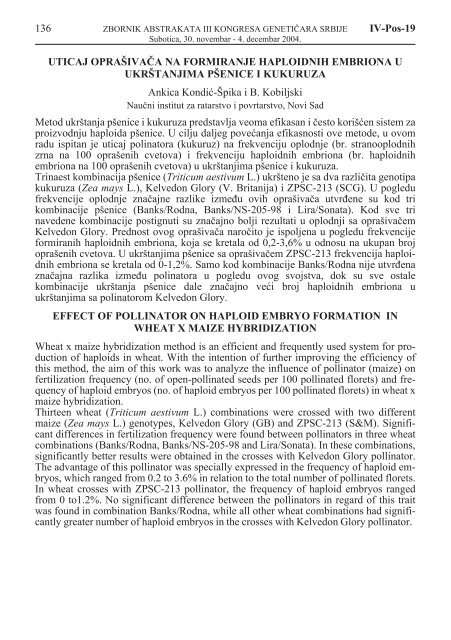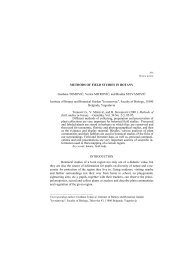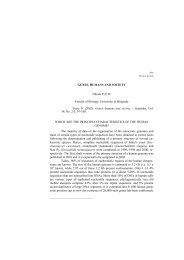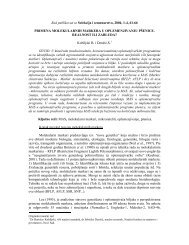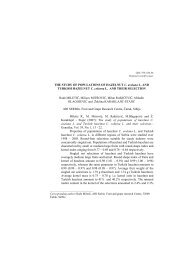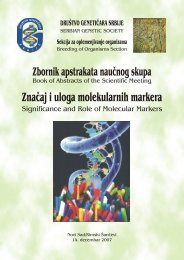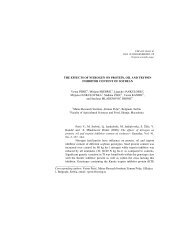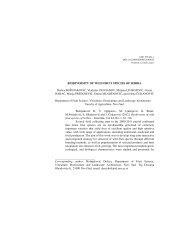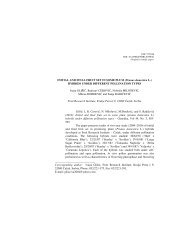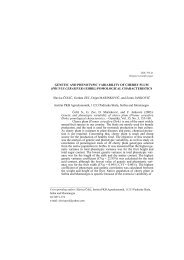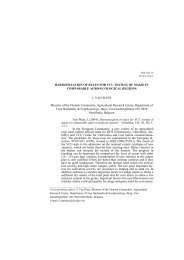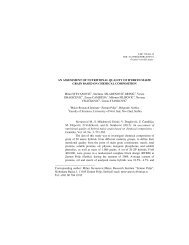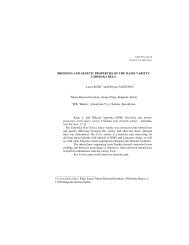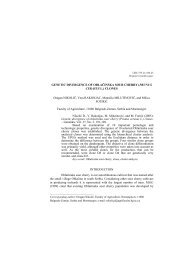Zbornik - Društvo genetičara Srbije
Zbornik - Društvo genetičara Srbije
Zbornik - Društvo genetičara Srbije
Create successful ePaper yourself
Turn your PDF publications into a flip-book with our unique Google optimized e-Paper software.
136 ZBORNIK ABSTRAKATA III KONGRESA GENETIÈARA SRBIJE IV-Pos-19<br />
Subotica, 30. novembar - 4. decembar 2004.<br />
UTICAJ OPRAŠIVAÈA NA FORMIRANJE HAPLOIDNIH EMBRIONA U<br />
UKRŠTANJIMA PŠENICE I KUKURUZA<br />
Ankica Kondiæ-Špika i B. Kobiljski<br />
Nauèni institut za ratarstvo i povrtarstvo, Novi Sad<br />
Metod ukrštanja pšenice i kukuruza predstavlja veoma efikasan i èesto korišæen sistem za<br />
proizvodnju haploida pšenice. U cilju daljeg poveæanja efikasnosti ove metode, u ovom<br />
radu ispitan je uticaj polinatora (kukuruz) na frekvenciju oplodnje (br. stranooplodnih<br />
zrna na 100 oprašenih cvetova) i frekvenciju haploidnih embriona (br. haploidnih<br />
embriona na 100 oprašenih cvetova) u ukrštanjima pšenice i kukuruza.<br />
Trinaest kombinacija pšenice (Triticum aestivum L.) ukršteno je sa dva razlièita genotipa<br />
kukuruza (Zea mays L.), Kelvedon Glory (V. Britanija) i ZPSC-213 (SCG). U pogledu<br />
frekvencije oplodnje znaèajne razlike izmeðu ovih oprašivaèa utvrðene su kod tri<br />
kombinacije pšenice (Banks/Rodna, Banks/NS-205-98 i Lira/Sonata). Kod sve tri<br />
navedene kombinacije postignuti su znaèajno bolji rezultati u oplodnji sa oprašivaèem<br />
Kelvedon Glory. Prednost ovog oprašivaèa naroèito je ispoljena u pogledu frekvencije<br />
formiranih haploidnih embriona, koja se kretala od 0,2-3,6% u odnosu na ukupan broj<br />
oprašenih cvetova. U ukrštanjima pšenice sa oprašivaèem ZPSC-213 frekvencija haploidnih<br />
embriona se kretala od 0-1,2%. Samo kod kombinacije Banks/Rodna nije utvrðena<br />
znaèajna razlika izmeðu polinatora u pogledu ovog svojstva, dok su sve ostale<br />
kombinacije ukrštanja pšenice dale znaèajno veæi broj haploidnih embriona u<br />
ukrštanjima sa polinatorom Kelvedon Glory.<br />
EFFECT OF POLLINATOR ON HAPLOID EMBRYO FORMATION IN<br />
WHEAT X MAIZE HYBRIDIZATION<br />
Wheat x maize hybridization method is an efficient and frequently used system for production<br />
of haploids in wheat. With the intention of further improving the efficiency of<br />
this method, the aim of this work was to analyze the influence of pollinator (maize) on<br />
fertilization frequency (no. of open-pollinated seeds per 100 pollinated florets) and frequency<br />
of haploid embryos (no. of haploid embryos per 100 pollinated florets) in wheat x<br />
maize hybridization.<br />
Thirteen wheat (Triticum aestivum L.) combinations were crossed with two different<br />
maize (Zea mays L.) genotypes, Kelvedon Glory (GB) and ZPSC-213 (S&M). Significant<br />
differences in fertilization frequency were found between pollinators in three wheat<br />
combinations (Banks/Rodna, Banks/NS-205-98 and Lira/Sonata). In these combinations,<br />
significantly better results were obtained in the crosses with Kelvedon Glory pollinator.<br />
The advantage of this pollinator was specially expressed in the frequency of haploid embryos,<br />
which ranged from 0.2 to 3.6% in relation to the total number of pollinated florets.<br />
In wheat crosses with ZPSC-213 pollinator, the frequency of haploid embryos ranged<br />
from 0 to1.2%. No significant difference between the pollinators in regard of this trait<br />
was found in combination Banks/Rodna, while all other wheat combinations had significantly<br />
greater number of haploid embryos in the crosses with Kelvedon Glory pollinator.


